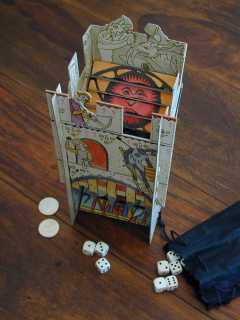

|
|
|
There are 3 ramps each with ribs to help randomize the fall of the dice. The tower is 8.25" (21 cm) high by 3.5" (9 cm) by 4" (10 cm) deep and is shown with U.S. quarters and 13mm dice for size comparison. All in all, it is a useful device for randomizing a dice roll and keeping the scattered dice from knocking over all the pieces on the game board.
Inspired, I decided to construct my own dice tower. I chose the material basswood, which is available in many hobby shops, is easy to cut, and in between balsa and pine wood in durability and hardness. I did not make paper plans, but I had an idea of the size and shape. Basically I wanted to make a 4 ramp tower, of about the same footprint as the Kuhlmann GeschichtsSpiele tower, but taller. My tower, shown in the picture at left, is exactly 1' (30.5 cm) high, because the basswood comes in 3' lengths and that would make good use of the stock length of the wood. The footprint is approximately 4" x 4" (10 cm) because that also is the stock width of the wood as it comes from the hobby shop.
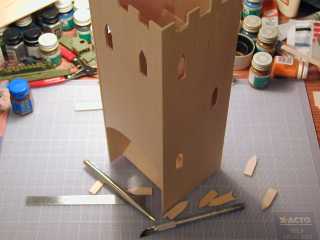
|
|
|
In this picture at left we see the windows that I have cut into the sides. Not only do the windows make the tower look more three dimensional, they also allow the sound of the falling dice to escape, somewhat like the holes in a acoustic guitar or violin help amplify the sounds within. Together with the nice hollow knock of the basswood, this tower make an excellent sound as the dice fall. The more dice the better the clatter!
Also notice the staggered top wall of the tower. This is completely unnecessary to the function of the tower, but it adds a bit of realism. When the tower was disassembled, I clamped all four side together and cut the pattern on the top part of the wood with the X-Acto saw. The wood splintered a bit so next time I am considering an alternate method to cut these dragon's teeth in the walls. Perhaps a small walkway and some HO scale figures would be cool too.
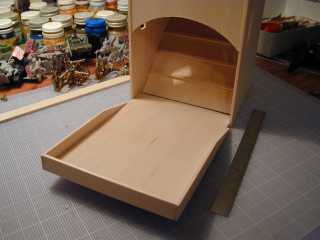
|
|
|
This picture also shows my messy hobby table. In the background are some Battle Cry figures waiting to be painted, a topic for some future article. I wish my house had a basement like my friend's houses in New Jersey have. Those guys have all sorts of wonderful projects going on: gaming, modelling, beer brewing, exercise areas. You would think central Texas with the proximity to tornado alley would have basements, but unfortunately I leave this mess in a spare room. As is my personality, I have 50 projects proceeding in parallel at my desk. But I digress.
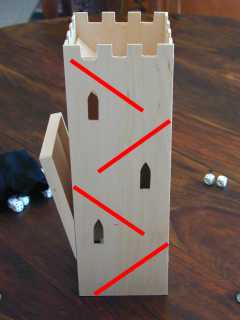
|
|
|
Each ramp has several ribs made from 1/8" (3mm) square stock. This is a bit too thick than what is needed, as the smallest 3mm dice sometimes get stuck in the tower. On the next tower I will use 1/16" lumber which I am sure will still be adequate to tumble the larger dice on their way down the tower.
Also notice the ramps are all situated front-to-back. I doubt anyone could try to cheat with this tower, but for additional randomization, it would have been better to situate the middle two ramps side-to-side. This would have tossed the dice sideways as well as back and forth on the way down. Perhaps this would foil an unscrupulous roller who places the 1 and 6 pips left and right to avoid rolling those numbers.
The windows are carefully situated to avoid seeing the ramps and give the impression that it is a true tower. However, notice the top left window shows the top ramp a little bit. My mistake. Next time I will have to plan more carefully.

|
|
|
What about painting or other decoration? I considered painting with acrylics, but I ran out of enthusiasm toward the end of the project. Another alternative is to decorate with water color art markers such as Berol's Prismacolor markers. Since these markers are water based, it would be good to coat the tower with polyeurathane after decorating, to prevent colors from running and to prevent finger oils from being absorbed into the wood. Another idea would be to print scenes from the Bayeux Tapestry with a computer printer, cut out the scenes, and paste them to the tower.
I opted to leave my tower unpainted. I didn't want to have a craft that no one would use, rather I wanted to have a good functional tool that would be used often.
Already I am dreaming plans for the next tower which I imagine will be cylindrical with a helical ramp within. If you have comments, or want to share gaming projects that you have done, I would be happy to hear about your works.
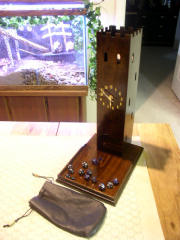
|
|
|
I received a nice email on this article from JR Hendricks, an engineering student at Texas Tech University in Lubbock, Texas. He read some of the articles here and came up with his own design for a dice tower.
First of all, notice the nice finish on this tower. Definitely heirloom quality, something to pass on to the kids. However, for me the best feature is the 13 hour clock. Also notice the similarity to the original. Nice crenellations at the top and nice staggered windows that hint at the ramps inside.
In all there are 6 ramps, and the tower stands 19 inches when on its base. Simple a great project that some one has suggested be named the "Glockenturm des dunklin Holzes" (Clocktower of Darkwood).